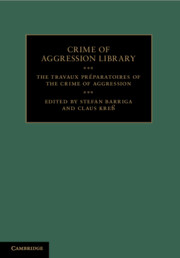Book contents
- Frontmatter
- Contents
- Contributors
- Foreword
- Preface
- Table of documents
- I Introduction to the negotiation history
- Negotiating the Amendments on the crime of aggression
- Negotiating the Elements of the crime of aggression
- Negotiating the Understandings on the crime of aggression
- II Amendments to the Rome Statute on the Crime of Aggression
- III Historical documents
- IV Travaux Préparatoires of the Amendments to the Rome Statute on the Crime of Aggression (1995–2010)
- V Index of Travaux Préparatoires
- References
Negotiating the Amendments on the crime of aggression
Published online by Cambridge University Press: 05 June 2014
- Frontmatter
- Contents
- Contributors
- Foreword
- Preface
- Table of documents
- I Introduction to the negotiation history
- Negotiating the Amendments on the crime of aggression
- Negotiating the Elements of the crime of aggression
- Negotiating the Understandings on the crime of aggression
- II Amendments to the Rome Statute on the Crime of Aggression
- III Historical documents
- IV Travaux Préparatoires of the Amendments to the Rome Statute on the Crime of Aggression (1995–2010)
- V Index of Travaux Préparatoires
- References
Summary
Introduction
Late at night on Friday, 11 June 2010, the States Parties to the Rome Statute of the International Criminal Court (Statute), gathered at the first Review Conference, adopted resolution RC/Res.6 on the crime of aggression. Annex I to the resolution contains six amendments to the Rome Statute incorporating the definition of the crime of aggression (new article 8 bis), certain conditions for the exercise of jurisdiction for State referrals and proprio motu investigations (new article 15 bis) as well as for Security Council referrals (new article 15 ter), a new paragraph 3 bis to be added to article 25 of the Statute confirming the leadership nature of the crime, and two technical changes to articles 9 and 20 of the Statute. Annex II contains the corresponding amendments to the Elements of Crimes. Annex III contains a set of interpretive understandings clarifying issues related, inter alia, to the principle of non-retroactivity, the conditions for Security Council referrals, the effects of the amendments on domestic jurisdiction over the crime of aggression, and the required magnitude of a State act of aggression.
The Kampala compromise is without a doubt a historic achievement. It provides a legally binding definition of the crime of aggression for the purpose of individual criminal justice at the international level and specifies the conditions under which the International Criminal Court (Court) may in the future exercise jurisdiction over the ‘supreme international crime’. The Kampala compromise is the culmination of international efforts to define and criminalise aggression that can be traced back to the Charters of the tribunals of Nuremberg and Tokyo and beyond. Another crucial event was the adoption on 14 December 1974 of UN General Assembly Resolution 3314 (XXIX) (GA Resolution 3314), which contains in its annex a ‘Definition of Aggression’. The text of that definition is not legally binding but is intended to offer guidance to the Security Council on determining the occurrence of a State act of aggression (as opposed to guiding a court for the purpose of ascertaining individual guilt). The International Law Commission (ILC), in turn, also undertook considerable efforts to define the crime of aggression as part of its work on the Draft Code of Crimes against the Peace and Security of Mankind.
- Type
- Chapter
- Information
- The Travaux Préparatoires of the Crime of Aggression , pp. 3 - 57Publisher: Cambridge University PressPrint publication year: 2011
References
- 3
- Cited by

